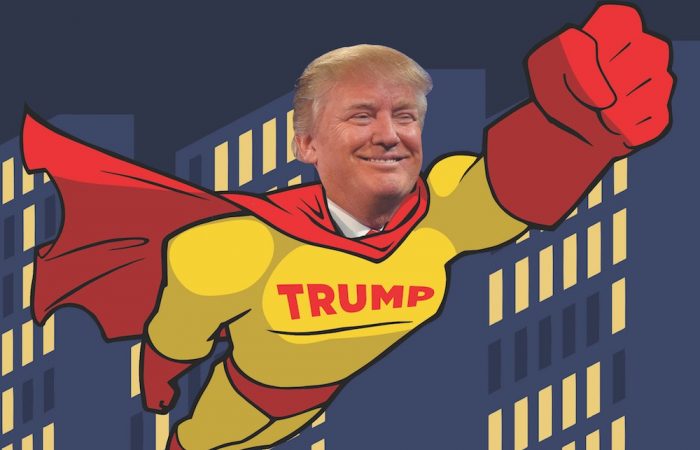
Donald Trump is a… hero?
By Dan McDonough, Jr.
President Trump is a hero.
Ok. Relax. This isn’t that kind of story. This is the story of Twitter, and how despite it sucking all the oxygen from the world’s newsrooms, Wall Street isn’t impressed.
First, let’s take a look at Twitter’s brand narrative, using the classic framework of the Hero’s Journey: Donald Trump, the would-be hero, faced the broken world of not being able to directly communicate with his prospective audience. The only real option seemed to be letting the media filter his message before distributing those parts of it they wished to release. Then came Trump’s mentor, Twitter, with its gift of a platform that could scale his unfiltered message limitlessly. Trump uses this gift from his mentor to conquer his broken world, reach his audience, and achieve his purpose.
Donald Trump is the hero of Twitter’s brand narrative, just as users and customers are the hero of any successful brand’s narrative.
Twitter has leveraged this narrative to become powerfully relevant. The world’s leader’s Tweets make their way to the front pages of the greatest newspapers and to primetime on the most watched networks. Twitter has powerfully changed the way conversations are carried. The character limitations of the platform have reshaped reporting from even the most storied newsgathering institutions. Take a look at this tweet from the New York Times as evidence:
While Trump’s opponents — including many journalists — immediately harnessed this compact nugget to unleash a tirade, quite a bit of the story was missing. However, because Twitter has become the feeder of news outlets, the balance of the story was tactically irrelevant.
Whatever your opinion is on the value of this new news reality Twitter has created, it’s hard to dispute Twitter’s influence on how we get critically important information. Yet despite this, Twitter’s stock price has shrunk some 60 percent since its IPO in 2013.
Why? Because Twitter quit iterating its story at the end of its first chapter.
Storytelling — especially in business — is something that must evolve and iterate. While the framework of the story shouldn’t change, the tactical elements and application must adapt to new audiences and outside influences. In that regard, Twitter has failed terribly. And Twitter isn’t the anomaly. Clayton M. Christensen uses an entire book to explain this problem in The Innovator’s Dilemma: plenty of really good companies have failed simply because they didn’t keep iterating their story when confronting different types of market and technological change. That has prevented Twitter from wooing investors and harnessing all of the relevance it has to date achieved.
One of the tech world’s most critical thinkers, Anil Dash, recently wrote a great treatise on how Twitter could reshape its trajectory. His ideas fall into some really good frameworks for building anecdotal stories:
- Show you can consistently ship new features.
- Directly handle abuse and tell the world what you’re doing.
- Stop using meaningless metrics as your measure of success.
- Provide specific tools for each of your types of users.
- Decide if you give a damn about developers or not.
When it comes to Twitter getting more respect from Wall Street, I’m a particular fan of the third item above. Dash goes on to write:
“Your relationship with Wall Street investors (and, to some degree, with advertisers) is fundamentally broken because you’ve gotten trapped into using the wrong metrics to measure the success or progress of Twitter.”
This is direct evidence that when a business stops telling its story, somebody else will come along and tell their own story about the business. In Twitter’s case, this void has been filled by analysts from investment banks. And they are looking at metrics that certainly do not tell the story Twitter should be amplifying.
“New signups are flat, and they’re going to stay flat, and every desperate flailing attempt to change that just reminds engaged users that they’re not seeing any progress and they don’t believe you can ship features they care about,” Dash writes. “Meanwhile, do you know how many new video creators joined YouTube this quarter? Me neither! You know why? Because all the good videos are on YouTube! What percentage of people who visit YouTube each month are logged in? What percentage ever uploaded a video? Answer: Nobody gives a shit. Because YouTube inarguably drives culture, and people (and advertisers!) want to be part of that.”
Twitter, just like YouTube, drives culture. In some serious respects, Twitter drives culture more than YouTube. (When was the last time anybody saw a news reporter’s YouTube handle in his or her byline or screen graphics?) But the metrics that matter don’t matter at all if Twitter doesn’t take the time to make them matter in the audiences it must influence.
“I’m not happy about the fact that Twitter helped Trump get elected, but it makes it damned obvious that investors watching your signup numbers have thoroughly missed the point,” says Dash. “Change the metrics, change the story, take the reins and lead them into a better understanding of the world than whatever meager measurements they got obsessed with in 2009.”
Donald Trump may not be Anil Dash’s hero. But he’s been one of the heroes of Twitter’s brand narrative through this entire presidential election and inauguration cycle. If Twitter doesn’t figure out how to leverage this chapter into the next one, its story will be relegated to history section of the bookstore.
Dan McDonough is a founding partner at Woden. Though he has never owned a share of its stock, he is “Twitter famous.” Whatever your storytelling needs may be, let Woden help. Read our free Storytelling Blueprint, or send us an email at connect@wodenworks.com to discuss how Woden can help build your story.


